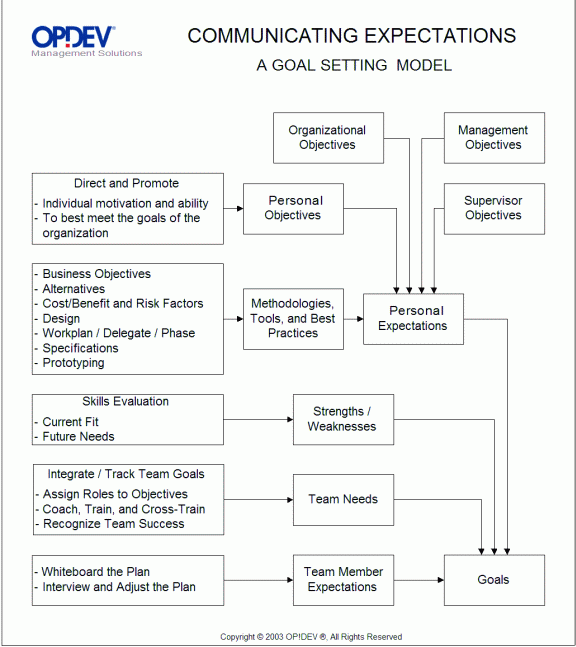Objectives and Goal Setting
Post on: 4 Февраль, 2016 No Comment

Questions to Ask:
- Is my objective broad?
- Is my objective non-measurable?
- Is my objective continuous, ongoing, and non-dated?
- Does my objective convert my mission/vision into action?
- Does my objective help to sustain my competitive advantage?
There were numerous articles on both short and long term objectives and planning. However, the most straightforward short reference guide was this piece from Purdue University. It is little more than a checklist for long-term and short-term goal setting. What made it useful as a future reference guide was a simple definition of long-term and short-term planning, and a brief statement connecting the two. One unusual aspect of the checklist was the suggestion that the planner consider long-term goals in relation to family values. This is probably more applicable to someone in the commercial sector (as suggested by the title), but the author submits that such comparisons are probably valid in most business situations.
- In what areas will we continue being actively involved in the future?
In this step the firms mission and vision is converted into tangible actions (objectives) and later into results (goals) to be achieved. Objectives are broad categories. They are non-measurable, non-dated, continuous, and ongoing. With objectives the company moves from motive to action. Objectives are the general areas in which your effort is directed to drive your mission statement. (Bobb Biehl)
To write an objective ask the questions:
- When creating a strategic plan, what 3-7 areas will our company continue being actively involved in the future? What areas do we need to be involved in to accomplish our mission statement? What is our company going to do about our competitive advantage categorically?
One of the best ways to tell whether or not an area is a clearly defined objective area, is to ask the question:
- Could I assign a person to be responsible for this area of activity?
If you can assign a person, on a continuing basis, to be responsible for everything going on in their area, it is probably a clear objective area.
Use the following criteria in evaluating your objective:
- Is my objective broad? Is my objective non-measurable? Is my objective continuous, ongoing, and non-dated? Does my objective help to sustain my competitive advantage? Does my objective convert my mission/vision into action? Could I assign a person to be responsible for this area of activity?
A few examples of objectives are:
- Expand sales to existing customers (build on a strength) Introduce existing products into a new market (build on a strength) Develop an incentive plan for research and development staff who are slow to innovate (correct a weakness)
Objectives are needed for each key area the company deems important to success. From a company perspective, there are distinct types of objectives:
Financial Objectives
Financial objectives focus on achieving acceptable profitability in a companys pursuit of its mission/vision, long-term health, and ultimate survival. Financial objectives signal commitment to such outcomes as good cash flow, creditworthiness, earnings growth, an acceptable return on investment, dividend growth, and stock price appreciation. (Thomas Strickland, p.7)

The following are examples of financial objectives:
- Growth in revenues Growth in earnings Wider profit margins Bigger cash flows Higher returns on invested capital Attractive economic value added (EVA) performance Attractive and sustainable increases in market value added (MVA) A more diversified revenue base
Strategic Market Objectives
Strategic market objectives focuses on the companys intent to sustain and improve the organizations competitive strength and long-term market position through
creating customer value.
Strategic objectives focus on winning additional market share, overtaking key competitors on product quality or customer service or product innovation, achieving lower overall costs than rivals, boosting the companys reputation with customers, winning a stronger foothold in international markets, exercising technological leadership, gaining a sustainable competitive advantage, and capturing attractive growth opportunities. (Thomas Strickland, p.7)
Strategic objectives need to be competitor-focused and strengthen the companys long-term competitive position. A company exhibits strategic intent when it pursues ambitious strategic objectives and concentrate its competitive actions and energies on achieving that objective. The strategic intent of a small company may be to dominate a market niche. The strategic intent of an up-and-coming company may be to overtake the market leaders. The strategic intent of a technologically innovative company may be to create a new product. Small companies determined to achieve ambitious strategic objectives exceeding their present reach and resources, often prove to be more formidable competitor than larger, cash-rich companies with modest strategic intents. (Thompson Strickland, p.39-40)
The following are examples of strategic market objectives:
- A bigger market share Quicker design-to-market times than rivals Higher product quality than rivals Lower costs relative to key competitors Broader or more attractive product line than rivals A stronger reputation with customers than rivals Superior customer service Recognition as a leader in technology and/or product innovation Wider geographic coverage than rivals Higher levels of customer satisfaction than rivals
Internal Operational Objectives
Internal operational objectives focus on business process that have an impact on creating customer value and satisfaction. Internal objectives focus on maintaining the firms core competencies.
Management objectives focus on running a major functional activity or process within a business, such as, research and development, production, marketing, customer service, distribution, finance, human resources, and other strategy critical activities. (Thompson Strickland, p.50)
Operational objectives focus on how a company manages frontline organizational units with a business (plants, sales districts, distribution centers) and how to perform strategically significant operating tasks (materials purchasing, inventory control, maintenance, shipping, advertising campaigns) (Thompson Strickland, p.51)
Small Business Unit (SBU)Objectives The companys mission and vision needs to be turned into detailed supporting objectives for each level of management. Each manager should have objectives and be responsible for reaching them. (Kotler, p.52)
Objective setting needs to be top-down in order to guide lower-level managers and organizational units toward outcomes that support the achievement of overall business and company objectives. A top-down process
- helps produce cohesion among objectives and strategies of different parts of the organization
- helps unify internal efforts to move the company along the chosen strategic plan. (Thompson Strickland, p.42)
Innovative and Learning Objectives
Innovative and learning objectives focus on activities that assist to improve and build the companys value creating activities. It involves increases the firms knowledge base and learning best practices so the company is continually on the cutting edge.
3A%2F%2F0.gravatar.com%2Favatar%2Fad516503a11cd5ca435acc9bb6523536%3Fs%3D48&r=PG /% chan
3A%2F%2F1.gravatar.com%2Favatar%2Fad516503a11cd5ca435acc9bb6523536%3Fs%3D48&r=PG /% Claude Hungerford
3A%2F%2F0.gravatar.com%2Favatar%2Fad516503a11cd5ca435acc9bb6523536%3Fs%3D48&r=PG /% muhanguzi joram kabugabo
3A%2F%2F0.gravatar.com%2Favatar%2Fad516503a11cd5ca435acc9bb6523536%3Fs%3D48&r=PG /% Kristin Larsen
OK, weve signed you up. Know that you can also sign yourself up at the bottom of the screen.
3A%2F%2F1.gravatar.com%2Favatar%2Fad516503a11cd5ca435acc9bb6523536%3Fs%3D48&r=PG /% waqas akbar
You have set up a small hardware Company named Tivoli Storage Manager (TSM) which has successfully survived in its 1st year. Now you want to set objectives of this company for the next ten years. You are required to write objectives both implicit and explicit to maintain the success rate of your company?
3A%2F%2F0.gravatar.com%2Favatar%2Fad516503a11cd5ca435acc9bb6523536%3Fs%3D48&r=PG /% Kristin Larsen
Hi Waqas, writing objectives are critical to an organizations success. Think ofthen as long-term, continuous strategic areas that help connect your mission to your vision. Holistic objectives (that align with balanced scorecard principles) encompass four areas: financial, customer, operational and people. These objectives help define what key activities you need to perform to achieve your vision. Does that answer your question?
3A%2F%2F0.gravatar.com%2Favatar%2Fad516503a11cd5ca435acc9bb6523536%3Fs%3D48&r=PG /% Anne
how do I start formulating strategic goals and objectives for a hospital?
3A%2F%2F0.gravatar.com%2Favatar%2Fad516503a11cd5ca435acc9bb6523536%3Fs%3D48&r=PG /% Shannon Sage
3A%2F%2F0.gravatar.com%2Favatar%2Fad516503a11cd5ca435acc9bb6523536%3Fs%3D48&r=PG /% Arif














